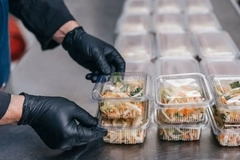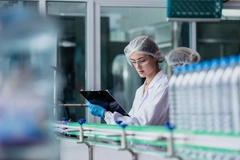Sustainable beverage packaging: Trends and innovation in alcohol containers

The beverage packaging industry is undergoing a transformation driven by environmental sustainability, consumer preferences and regulatory pressures. Companies are at the forefront of this shift, championing solutions such as PET and rPET bottles that reduce carbon emissions, enhance recyclability and offer modern design elements.
The packaging landscape is seeing a gradual move away from traditional materials like heavy glass and non-recyclable plastics. Daniel Lehner, global sales director for food and beverage at Alpla, tells Packaging Insights: “There are physical and chemical limits to the use of plastic. But in principle, a solution can be found for every area, which also explains the success and use of plastic worldwide.”
“We see the use of plastic in all market areas. But it is precisely in areas of ‘traditional packaging’ where the material has already become representative for the product range that we are facing the challenges with new developments.”
Packamama’s spokesperson echoes this sentiment, highlighting a clear shift away from heavy, difficult-to-recycle materials like certain plastics and traditional glass bottles.
“This change is driven by several factors, with cost being a primary consideration. Lighter glass bottles generally cost less than heavier ones. However, the main driver is the growing demand from retailers, who are prioritizing producers that align with sustainability goals.”
 Daniel Lehner, global sales director for food and beverage at Alpla.“This trend is further supported by the rise of extended producer responsibility (EPR) regulations, which hold producers accountable for the entire lifecycle of their products, including post-consumer disposal and recycling. As a result, manufacturers are increasingly opting for packaging materials that are easier to recycle and more cost-effective in meeting these compliance requirements.”
Daniel Lehner, global sales director for food and beverage at Alpla.“This trend is further supported by the rise of extended producer responsibility (EPR) regulations, which hold producers accountable for the entire lifecycle of their products, including post-consumer disposal and recycling. As a result, manufacturers are increasingly opting for packaging materials that are easier to recycle and more cost-effective in meeting these compliance requirements.”
Design innovations
The beverage packaging sector is witnessing shifts in consumer preferences. Innovation is a driving force behind the rise of next-generation packaging.
“We’ve certainly observed significant curiosity and interest in the shape, material and practicality of our packaging,” says Packamama’s spokesperson. “Consumers are considering factors like how easily it fits into their shopping bags with other items, how well it fits in their fridge, how much more wine it allows them to carry and how the bottle strikes a balance between strength and lightness.”
“We also see a trend toward offering the same beverage in multiple packaging options, catering to different drinking occasions. Reusable packaging is growing, reflecting consumer preferences for sustainability and experiences over assets.”
“Additionally, the fact that the bottle is shatterproof has been a major plus for many customers. This combination of functionality and eco-friendliness has captured the attention of those looking for a sustainable packaging solution that doesn’t compromise on convenience.”
Alpla’s PET wine bottle is an example of how modern design can meet sustainability goals.
“Our first PET wine bottle is aimed at environmentally conscious buyers and those who want to consume wine quickly or occasionally. In the retail trade, it is ideal for quick turnover and short-term storage, as the full aroma is retained for around six months,” says Lehner.
“In an effort to fully recycle the bottle after use, Alpla has foregone the use of a special protective coating. The PET wine bottle, therefore, offers a modern, sustainable experience of enjoyment, perfect for an urban, mobile lifestyle.”
Meanwhile, Packamama’s spokesperson highlights that consumers are drawn to the practicality and eco-friendliness of rPET flat bottles.
“Industries like wine and spirits are focusing on reducing packaging weight and transitioning to more sustainable options like rPET, biodegradable materials and other modern solutions. However, materials like cardboard present challenges due to their poor performance in moisture resistance and as a gas barrier.”
“It’s also worth noting the significant difference between glass, a material that has been in use for thousands of years, and PET, which emerged as a more recent and innovative solution to packaging challenges.”
Carbon footprint reduction
Alpla’s PET wine bottles reduce carbon emissions by 38% compared to glass bottles. Alpla is in the PET world in the beverage sector and is in favor of closed loops and cycles within a market segment (Image credit: Alpla).
Alpla is in the PET world in the beverage sector and is in favor of closed loops and cycles within a market segment (Image credit: Alpla).
“The advantages of PET can be demonstrated particularly well in the beverage sector. Regarding the development of PET over the last two decades, it can be said that the boom is particularly associated with the three material properties of safety, affordability and sustainability and the use of post-consumer recycled material, good recyclability and lightweight. This makes it the ideal material for this type of application and in this sector,” highlights Lehner.
Packamama’s efforts are aligned with similar goals. By prioritizing lightweight rPET flat bottles, carbon emissions can be reduced throughout the entire product lifecycle.
“As demand for low-emission materials rises, the alcohol packaging sector is adapting to meet these needs. Consumers are becoming more conscious of the environmental impact of their choices, often favoring companies with a clear mission over established brands.”
“Packaging is a major contributor to GHG emissions in the alcohol industry, prompting companies to adopt more sustainable practices. As environmental awareness grows, packaging solutions that protect the planet are widely supported.”
Role of awareness
While the benefits of sustainable packaging are clear, Packamama emphasizes the importance of consumer awareness in addressing challenges to industry-wide adoption.
 Packamama offers a barrier solution in its eco-flat wine bottles (Image credit: Packamama).“Educating customers or tapping into already-informed consumers will transform how people perceive traditional glass wine bottles. While I acknowledge that some wines do require glass for aging to achieve their full flavor, it’s essential to note that this represents a small fraction of the global wine market — likely less than 15% of the total global volume.”
Packamama offers a barrier solution in its eco-flat wine bottles (Image credit: Packamama).“Educating customers or tapping into already-informed consumers will transform how people perceive traditional glass wine bottles. While I acknowledge that some wines do require glass for aging to achieve their full flavor, it’s essential to note that this represents a small fraction of the global wine market — likely less than 15% of the total global volume.”
“For the everyday wines we enjoy with friends and family, it’s time to reconsider the need for a centuries-old invention in today’s modern world. It doesn’t make sense to store wines meant to be consumed within 1–2 years in a heavy bottle molded at over 1500°C from sand, a material that is not only scarce but also contributes to the erosion of coastlines.”
Packamama’s spokesperson shares that Nordic Monopolies are giving more shelf space to PET bottles and bags in boxes for wine instead of glasses, as they want to support companies that follow sustainable practices and encourage behavior change among consumers.
The company also notices that consumers are increasingly seeking solutions that reduce scarcity by reusing materials, use less energy, produce lower emissions and serve a practical purpose both before and after use. As consumers become more conscious of environmental issues, they also want packaging that is easy to recycle.
“While glass is recyclable, that alone doesn’t justify its ongoing use for single-use packaging, especially when it’s produced at such high temperatures.”
“It’s likely that companies that prioritize sustainable practices will be increasingly recognized for their efforts. At the same time, those who have yet to embrace these changes may find themselves facing mounting pressure as consumer expectations shift toward more eco-conscious choices,” Packamama concludes.











